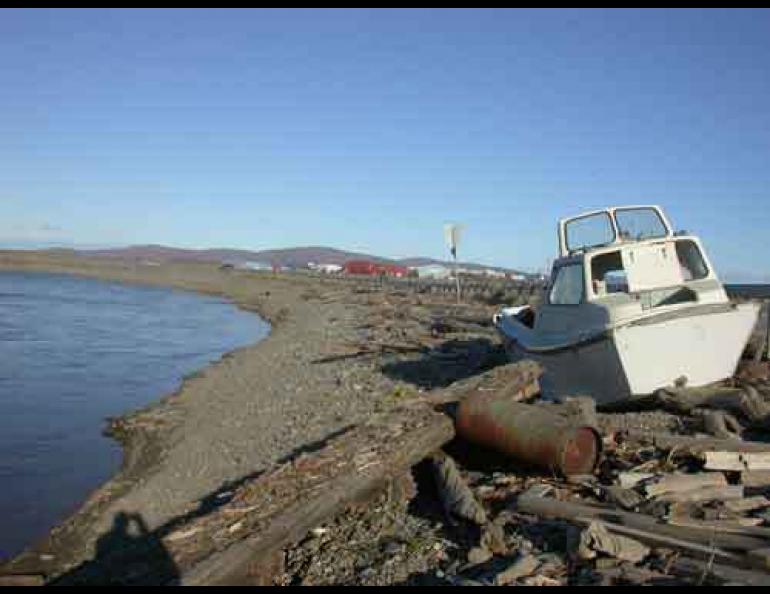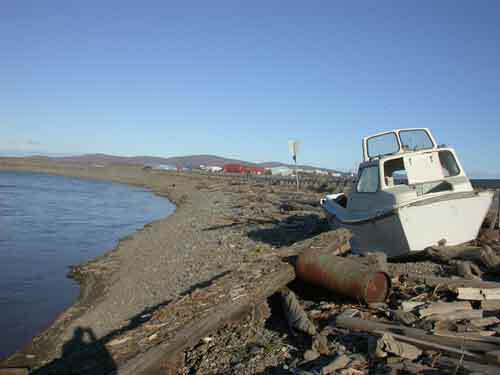
No hurricanes in Alaska, but...
While some people in Nome held a recent Cajun-food fundraiser for New Orleans hurricane victims, “the tail end of a Bering Sea storm rattled the windows,” wrote Nancy McGuire in the Nome Nugget.
Hurricanes, tropical by definition, don’t strike in Alaska, but extreme weather hammers the state’s exposed West Coast and Aleutian Islands each fall and winter.
“Storms that affect Alaska are far, far bigger than hurricanes,” said Rick Thoman, lead forecaster at the National Weather Service's Fairbanks Forecast Office. “Hurricanes are tiny compared to great storms that take up a quarter of the Bering Sea.”
Nome and other towns of Alaska's West Coast have taken the brunt of fall storms that churn up the Bering Sea before the protective cap of sea ice forms. In October 2004 and September 2005, large storms brought high winds and storm surges—high water that causes flooding—into villages and towns.
“That’s back-to-back years when we were ranked in the top 10 storms in Nome’s history,” said Jerry Steiger, meteorologist in charge at the Nome office of the National Weather Service.
During a late September storm, low-lying Seward Peninsula villages took on water in ways similar to New Orleans. In Golovin, flooding made the lower part of the town into an island. “We had our own little hurricane Rita,” Librarian Jerri Nagaruk of neighboring Elim told Sandra Medearis of the Nome Nugget.
Nome has a seawall made of giant boulders to protect it against the wind-whipped ocean, but many Alaska West Coast villages are at, or near, sea level and are vulnerable to storm surges.
“Unfortunately, people established those towns right next to water,” Steiger said. “It’s not the best place to be in a storm.”
Steiger said the storms on Alaska’s West Coast are similar to hurricanes in that they cause storm surges and spin in a counterclockwise motion, but they “usually aren’t wound as tight” as a hurricane.
“A big low can affect most of western Alaska,” he said. “These systems are so large they’re drawing moisture from all over the Bering Sea.”
These huge storms, which happen on the West Coast and the Aleutians most often from September to January, can generate strong winds over a broad swath of Alaska.
“Yesterday, when (hurricane) Wilma was the lowest pressure ever recorded in the Atlantic Basin, hurricane force winds only extended 60 miles out from the center,” Thoman said in Fairbanks. During an extreme Alaska storm, “there can be strong winds at Bethel and Nome (300 miles apart) at the same time.”
The National Weather Service defines hurricane-force winds as 74 miles per hour and greater. During the September storm on the Seward Peninsula that sent woody debris over a good portion of Nome’s Front Street, an unofficial wind gauge at a boat repair shop recorded a gust of 83 miles per hour. Steiger reported official gusts of 56 miles per hour in Nome and 66 miles per hour in Golovin.
Weather in the Aleutian Islands can be among the most extreme in Alaska or anywhere else in the world. In December 1950, a wind gauge on Attu, a far-west island of the Aleutians, read a gust of 159 miles per hour. In 1959, an instrument at nearby Shemya recorded a 139 mile-per-hour gust.
Vast oceans surrounding the western Aleutians aren’t the only reasons the islands are prone to extreme weather.
“The Aleutians aren’t all that far from Siberia,” Thoman said. “They can tap into some extremely cold air, and the difference between warm and cold air is what fuels storms.”




